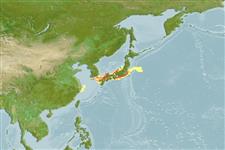>
Ophidiiformes (Cusk eels) >
Bythitidae (Livebearing brotulas)
Etymology: Parabrotula: Greek, para = the side of + Latin, brotula, -ae = little, bud, shoot (Ref. 45335); tanseimaru: Named after R/V Tansei Maru.
Eponymy: ‘Tansei Maru’ is the name of a research vessel, owned by the Ocean Research Institute, University of Tokyo (now Japan Marine Science and Technology Center), which was responsible for collecting the holotypes of the goby and false brotula. (Ref. 128868), visit book page.
More on authors: Miya & Nielsen.
Environment: milieu / climate zone / depth range / distribution range
بوم شناسي
دريايي ناحیه ای از منطقه اقیانوسی با عمق بین 1000 تا 4000 متر. موجوداتی که در آبهای آزاد بین اعماق 1000 تا 4000 متر زندگی و تغذیه می کنند; تغييرات عمق 0 - 1300 m (Ref. 34721). Deep-water
Northwest Pacific: Japan.
Size / Weight / سن
Maturity: Lm ? range ? - ? cm
Max length : 5.0 cm SL جنس نر / بدون خواص جنسي; (Ref. 34721); 5.0 cm SL (female)
Occurs in pseudoceanic bathypelagic depths. Feeds primarily on copepods (Ref. 34721). Viviparous (Ref. 34721).
Life cycle and mating behavior
بلوغ | تولید مثل | تخم ریزی | تخم ها | Fecundity | توزاد ( لارو)
Miya, M. and J.G. Nielsen, 1991. A new species of the deep-sea fish genus Parabrotula (Parabrotulidae) from Sagami Bay with notes on its biology. Jap. J. Ichthyol. 38(1):1-5. (Ref. 34721)
وضعيت در فهرست قرمز IUCN (Ref. 130435: Version 2024-2)
خطر برای انسان ها
Harmless
استفاده انسانی
ابزارها
گزارش های ويژه
بارگيری XML
منابع اينترنتي
Estimates based on models
Preferred temperature (Ref.
123201): 0.7 - 16.4, mean 8.5 °C (based on 34 cells).
Phylogenetic diversity index (Ref.
82804): PD
50 = 0.8750 [Uniqueness, from 0.5 = low to 2.0 = high].
Bayesian length-weight: a=0.00813 (0.00246 - 0.02688), b=2.92 (2.67 - 3.17), in cm total length, based on LWR estimates for this (Sub)family-body shape (Ref.
93245).
Trophic level (Ref.
69278): 3.0 ±0.00 se; based on food items.
جهندگی (Ref.
120179): زياد, كمينه زمان لازم براي دو برابر شدن جمعيت ، كمتر از 15 ماه (Preliminary K or Fecundity.).
Fishing Vulnerability (Ref.
59153): Low vulnerability (10 of 100).
